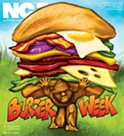[
{
"name": "Top Stories Video Pair",
"insertPoint": "7",
"component": "17087298",
"parentWrapperClass": "fdn-ads-inline-content-block",
"requiredCountToDisplay": "1"
}
]
As the prime garden season winds down, you might think you wouldn't have to deal with pests in the garden. You would be wrong. Especially after that unexpected rainfall we had a few weeks ago. Do you know what lots of rain followed by warm weather means? Yes, mosquitoes! Just when all the rain gutters, loose tarps and saucers under your potted plants had finally dried out, we get 1 to 3 inches of rain in which mosquitoes can breed.
I noticed a huge increase in the little bloodsuckers here at my place, so that meant it was time to haul out the Bucket of Doom again. You can search bucket of doom on the internet — ui.charlotte.edu has information on how it can be used instead of pesticides. All you need is a 5-gallon bucket, water, some straw or grass, and some mosquito dunks, also known as BT (Bacillus thuringiensis). They really do work. I don't generally recommend those bug zappers because they don't just zap the mosquitoes, they also zap other beneficial insects.
Another excellent mosquito control is swallows (which have mostly left the area by now) or bats. A single bat can eat up to 1,200 insects per hour, so that's some serious mosquito control. Bat houses are easy to set up; just make sure you read the instructions. At least 10 feet off the ground, south facing, with a water source nearby are ideal locations.
Another one of Humboldt's favorite pests that adores a late summer rain is none other than the slug. Those slimy little creatures have been hiding in crevices, under boards, you name it. When all that glorious rain happened, they came out of hiding in droves. So what to do about this particular pest? You have several options. The one I use most here at home and in my clients' yards is Sluggo. You can find it at most nurseries or Costco carries it at different times of the year. Until recently, I was only able to find it at Costco when it brings out the garden stuff, probably sometime in December, since Halloween showed up at the end of July. But this year, it had more in stock as recently as two weeks ago.
Another option to deal with the little slime-makers is small saucers of beer. You can use an empty yogurt or other plastic container, sink it into the ground so it's nearly level with the soil, then add beer. Preferably the cheapest beer you can find. The slugs at my place prefer Natural Ice. But then the raccoons found the saucers and had a kegger, slurping up all the beer. So much for that option.
Another option, that I know won't work for everyone, is get yourself some ducks. Ducks are excellent slug patrol. Sure, they're messy and may wander off to get eaten by a fox when you're not looking, but if you're able to keep them corralled in your garden, you'll have it cleared of slugs and snails in no time.
So we've taken care of the slugs and the mosquitoes, what else may be bothering your zucchini and tomato plants? Why, that would be my No. 1 nemesis: black-tailed deer, or, as I like to call them, Cloven-Hooved Devil Spawn (CHDS). Deterring CHDS has become my life's mission. The only tried and true method is an 8-foot fence around your garden. Deer repellent sprays do work, but you must reapply after a rain and make sure you spray at least once a week, otherwise the deer will nosh on your petunias when the scent has worn off. Other methods like human hair, Irish Spring soap and net bags filled with dryer sheets have been shown not to work, but they sure make lovely garden decorations.
So when is a pest not a pest? I see folks post on various garden pages on social media about something eating their precious plants. Usually it's followed by, "What do I spray to make them die forever?" Please don't reach for the poison spray; it kills everything, not just the target insect. More importantly, it's a good idea to identify what is eating the plant. One of the most common queries I see is when someone finds small circles cut out of leaves, such as wisteria, roses, dahlias and many more. These are the handiwork of the leaf cutter bee (Megachilidae). They are an important pollinator, so I always do a little happy dance when I see evidence of their cuttings in my garden. They build their tiny nests in cavities, usually made up of rotting wood, but not always. I see them collecting pollen on many flowers in gardens and you can tell they're leafcutters, because they have cute little yellow bums, which often stick up in the air when they're collecting pollen and nectar.
And finally, one of the more common pests in Humboldt gardens and orchards is the tunnel dwelling buck-toothed rodent: the gopher. They can take down an entire bed of garlic in a few days or gnaw on your apple tree's roots until the tree finally dies. I know, because it's happened to me.
Again, please don't reach for that poison. Most rodent poisons have secondary lethality, which means that the animal or bird that eats the dead gopher will also die or get very, very sick. For gophers, you gotta go lethal traps. My personal fave that I rave about to everyone who will stand still long enough, is the GopherHawk brand. I've also had luck with the black tube traps and Macabee traps. But for my money, the GopherHawk wins hands down. And you don't even have to touch the carcass.
Happy hunting!
Julia Graham-Whitt (she/her) is owner and operator of the landscaping business Two Green Thumbs.
more from the author
-
Summer Survival in the Garden
- Jul 18, 2024
-
Working it Out in the Garden
- Jan 18, 2024
-
Winter Planting for Future Color
- Dec 21, 2023
- More »
































